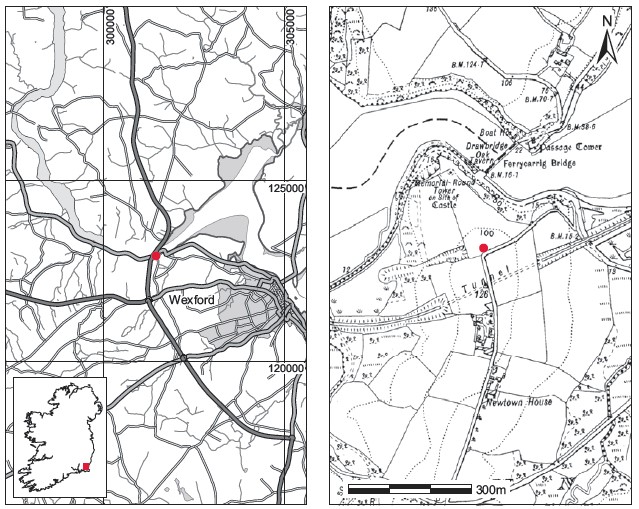County: Wexford Site name: NEWTOWN, CO. WEXFORD
Sites and Monuments Record No.: SMR WX037-029 Licence number: E1189
Author: MAEVE SIKORA
Site type: Early Bronze Age graves
Period/Dating: —
ITM: E 701386m, N 622979m
Latitude, Longitude (decimal degrees): 52.349026, -6.511836
In January 1984 a cremation and an urn were discovered near Wexford town during bulldozing operations on the site of a new house. ‘White ashes’ are reported to have been found around the vessel. The base and body of the pit were cut by the JCB. The finds were deposited in the NMI by Dr Edward Culleton, An Foras Talúntais. The site was not investigated, as it was not reported and was destroyed upon discovery. The fragments of cremated bone were examined by Barra Ó Donnabháin.
Location (Fig. 3.232)
The site was in the townland of Newtown, south-east Co. Wexford.367 It was located just south of Ferrycarrig bridge, close to the Slaney estuary and some 2km west of Wexford town, at an altitude of about 30m above sea level. No other early Bronze Age sites are listed in the SMR for OS sheet 37.
Description of site
As the find-place was destroyed upon discovery, there was no evidence of a cist or pit. The fact that no slabs were mentioned as being found around the urn would suggest that this was a pit burial. The remains were found to represent an adult or young adult (1984:112.2).
Collared urn, 1984:112.1 (Fig. 3.233)
The surviving portion of a collared urn, consisting of six large rim sherds (comprising about three-quarters of the original circumference of the vessel), six large body sherds and some smaller body sherds. No base sherds were recovered. The decoration is confined to the rim and the collar, the neck and body being left plain. The rim decoration consists of four irregular rows of whipped cord impressions running circumferentially. The decoration on the collar consists of rows of zigzag lines running along the width of the collar, also in whipped


cord. The motifs run slightly over the collar/neck break. The fabric is reasonably fine but there are large mica and quartz inclusions. The colour varies from black to grey/black internally to orange/red externally.
Dimensions: est. ext. D 38cm; W rim 2.5cm.
Comment
The human remains from this site have not been dated. The vessel is similar in type to a collared urn from Creggan, Co. Antrim (Kavanagh 1976, 341, fig. 16, no. 8), which Brindley (2007, 217, fig. 80l) places in stage 2 of collared urn development, dated to between 1800 BC and 1700 BC (Brindley 2007, 328).
HUMAN REMAINS
BARRA Ó DONNABHÁIN
The site was disturbed subsequent to its discovery and only four fragments of cremated bone (1984:112.2) were recovered. These are all calcined and have been efficiently incinerated. The four pieces of bone vary in length from 9.55mm to 29mm and have a total weight of just 2.6g.
It was possible to identify three of the four fragments and these appear to be human remains. The longest fragment is a portion of the shaft of a long bone; there is also a piece of the shaft of a radius. The third fragment appears to be a portion of a vertebra, while the smallest piece of bone is unidentifiable. The general size and thickness of the fragments suggests that these remains come from an adult or an older adolescent.
367. Parish of St Peter’s, barony of Forth. SMR WX037-029——. IGR 301458 122929.